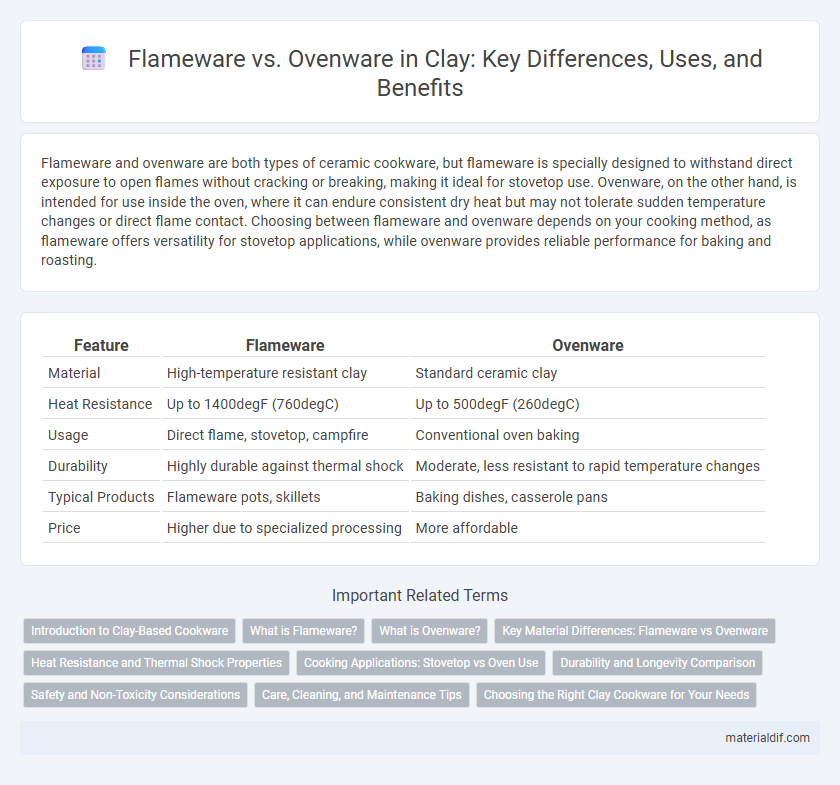Flameware and ovenware are both types of ceramic cookware, but flameware is specially designed to withstand direct exposure to open flames without cracking or breaking, making it ideal for stovetop use. Ovenware, on the other hand, is intended for use inside the oven, where it can endure consistent dry heat but may not tolerate sudden temperature changes or direct flame contact. Choosing between flameware and ovenware depends on your cooking method, as flameware offers versatility for stovetop applications, while ovenware provides reliable performance for baking and roasting.
Table of Comparison
| Feature | Flameware | Ovenware |
|---|---|---|
| Material | High-temperature resistant clay | Standard ceramic clay |
| Heat Resistance | Up to 1400degF (760degC) | Up to 500degF (260degC) |
| Usage | Direct flame, stovetop, campfire | Conventional oven baking |
| Durability | Highly durable against thermal shock | Moderate, less resistant to rapid temperature changes |
| Typical Products | Flameware pots, skillets | Baking dishes, casserole pans |
| Price | Higher due to specialized processing | More affordable |
Introduction to Clay-Based Cookware
Clay-based cookware includes both flameware and ovenware, each designed to withstand specific cooking conditions. Flameware is crafted from heat-resistant clay that tolerates direct open flames without cracking, making it ideal for stovetop use. Ovenware, on the other hand, is fired at higher temperatures to achieve thermal shock resistance, ensuring durability during prolonged baking in conventional or convection ovens.
What is Flameware?
Flameware is a type of clay specifically formulated to withstand direct flame and high heat without cracking or breaking, making it ideal for stovetop cooking. Unlike regular ovenware, which is designed primarily for consistent oven heat, flameware can endure rapid temperature changes and direct contact with flames. This durability allows flameware to be used for tasks like simmering, broiling, and even open flame grilling, expanding its versatility in culinary applications.
What is Ovenware?
Ovenware is a type of ceramic or glass cookware specifically designed to withstand high temperatures in conventional ovens without cracking or breaking. Made from materials like stoneware, porcelain, or tempered glass, ovenware ensures even heat distribution for consistent cooking results. Unlike flameware, which is suitable for direct flame or stovetop use, ovenware excels in baking, roasting, and broiling applications.
Key Material Differences: Flameware vs Ovenware
Flameware is crafted from dense, refractory clays that withstand direct flame exposure and rapid temperature changes without cracking, while ovenware typically uses lighter, less heat-resistant clay formulated for gradual heating in conventional ovens. Flameware often incorporates a higher silica content and a vitrified surface to enhance thermal shock resistance, contrasting with ovenware's porous structure designed for even heat distribution at lower temperatures. These material distinctions make flameware ideal for stovetop or open flame use, whereas ovenware suits baking and roasting in controlled oven environments.
Heat Resistance and Thermal Shock Properties
Flameware is specifically designed to withstand direct exposure to open flames and sudden temperature changes, making it ideal for stovetop cooking, while ovenware is optimized for consistent, gradual heat in ovens. Heat resistance in flameware typically reaches up to 700degF (371degC) or higher, whereas ovenware generally performs best below 500degF (260degC). The thermal shock resistance in flameware is superior, preventing cracking when moving between high-heat and cooler environments, unlike most ovenware which may crack under rapid temperature shifts.
Cooking Applications: Stovetop vs Oven Use
Flameware is specifically designed to withstand direct exposure to stovetop flames, making it ideal for cooking methods that require direct heat such as simmering or frying. Ovenware, on the other hand, is engineered to endure consistent, high-temperature oven environments, perfect for baking, roasting, and slow-cooking applications. Understanding the heat tolerance and intended use of flameware versus ovenware ensures optimal performance and safety in culinary practices.
Durability and Longevity Comparison
Flameware, designed to withstand direct flame and high heat, typically features enhanced thermal shock resistance, making it more durable for stovetop and open flame cooking than standard ovenware. Ovenware, while durable for consistent oven temperatures, may degrade faster under sudden temperature changes or direct flame exposure. The longevity of flameware surpasses ovenware in environments with frequent temperature fluctuations due to its specialized clay composition and firing process.
Safety and Non-Toxicity Considerations
Flameware is specifically designed to withstand direct flame and rapid temperature changes, making it safer for stovetop use without releasing harmful substances. Ovenware, while excellent for baking, typically cannot endure direct flame and may crack or emit toxins under high heat exposure. Choosing flameware ensures non-toxic durability for cooking methods involving open flames, while ovenware prioritizes safe, gradual heat distribution in enclosed ovens.
Care, Cleaning, and Maintenance Tips
Flameware and ovenware require different care to maintain their durability and performance; flameware, designed for direct heat, should be gently washed by hand to avoid thermal shock and cracking, while ovenware can often tolerate dishwasher cleaning but benefits from hand washing to preserve its glaze. Avoid using abrasive sponges or harsh chemicals on both flameware and ovenware, as these can damage the surface and cause staining or dullness. Regular seasoning or proper storage, such as avoiding stacking without protection, helps prevent chipping and extends the lifespan of clay cookware.
Choosing the Right Clay Cookware for Your Needs
Flameware and ovenware differ primarily in their heat resistance and use cases, with flameware designed to withstand direct flame and rapid temperature changes, making it ideal for stovetop cooking and grilling. Ovenware is crafted to endure prolonged, consistent oven heat, perfect for baking and roasting without thermal shock. Selecting the right clay cookware depends on your cooking method: opt for flameware if you frequently cook over open flames or stovetops, while ovenware suits those who rely on oven-based recipes for even heat distribution.
Flameware vs Ovenware Infographic

 materialdif.com
materialdif.com